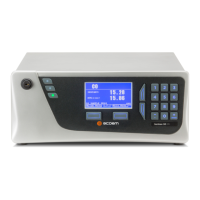TÜV Rheinland Energie und Umwelt GmbH
Luftreinhaltung
Report on the performance testing of the Serinus 30 ambient air quality moni-
toring system manufactured by Ecotech Pty Ltd measuring CO, Report no.:
936/21221977/D_EN
EP_Ecotech_Serinus30_en.docx
7. Test results in accordance with DIN EN 14626 (2012)
7.1 8.4.3 Response time
Neither the response time (rise) nor the response time (fall) shall exceed 180 s. The
difference between rise and fall response time shall not exceed 10 s.
7.2 Test procedure
The determination of the response time shall be carried out by applying to the analyser a
step function in the concentration from less than 20 % to about 80 % of the maximum of the
certification range of carbon monoxide and vice versa.
The change from zero gas to span gas and vice versa needs to be made almost instantane-
ously, with the use of a suitable valve. The valve outlet shall be mounted direct to the inlet of
the analyser, and both zero gas and span gas shall have the same amount of gas in excess,
which is vented by the use of a tee. The gas flows of both zero gas and span gas shall be
chosen in such a way that the dead time in the valve and tee can be neglected compared to
the lag time of the analyser system. The step change is made by switching the valve from ze-
ro gas to span gas. This event needs to be timed and is the start (t = 0) of the (rise) lag time
according to Figure 9. When the reading is stable to 98 % of the concentration applied, the
span gas can be changed to zero gas again; this event is the start (t = 0) of the (fall) lag time.
When the reading is stable to 2 % of the concentration applied, the whole cycle as shown in
Figure 9 is complete.
The elapsed time (response time) between the start of the step change and reaching 90 % of
the analyser final stable reading of the applied concentration shall be measured. The whole
cycle shall be repeated four times. The average of the four response times (rise) and the av-
erage of the four response times (fall) shall be calculated.
The difference in response times shall be calculated according to:
where
t
d
is the difference between response time (rise) and response time (fall), in s;
t
r
is the response time (rise) (average of the four response times – rise), in s;
t
f
is the response time (fall) (average of the four response times – fall), in s.
t
r
, t
f
and t
d
shall comply with the performance criteria as specified above.

